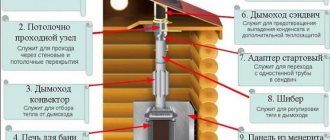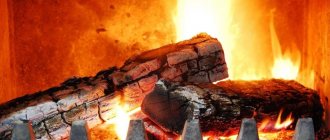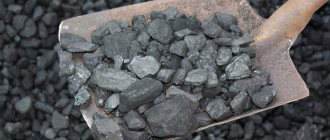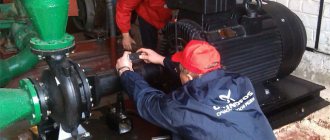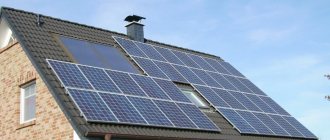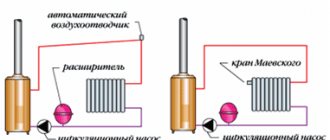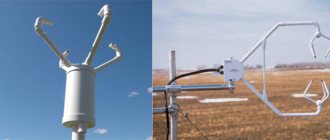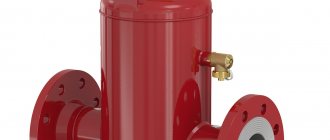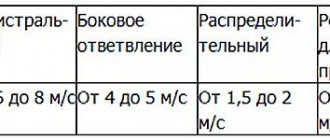The combustion process of solid fuel is divided into three stages:
- ignition (ignition),
- active combustion
- afterburning.
- In the first stage, solid fuel is first heated and dried and at a temperature of 105 - 110 ° C loses its moisture.
- Then, at a temperature of 300 – 400 °C, it begins to decompose into volatile substances and a solid residue.
- With further heating, when its temperature becomes equal to the ignition temperature, the fuel ignites. The ignition temperature (approximate) of various fuels is as follows, °C: firewood - 300; brown coal – 300 – 400; coal – 450 – 500; anthracite – 700 – 750; liquid fuel 500 – 600; about 600 gas.
- The active combustion stage is characterized by high temperature (more than 1000 °C) with maximum heat release and the highest consumption of air (oxygen) spent on the combustion of coke and volatile substances.
- Afterburning of solid fuel is characterized by decreasing heat release and decreasing demand for air.
Article: Double combustion. Secondary combustion of flue gases
Hello, dear friends!
Double combustion technology. Secondary combustion of flue gases is clean combustion.
Most modern fireplaces and stoves are equipped with a “double combustion” system or, as it is also called, “secondary combustion of flue gases.”
If you have already become familiar with the advantages of this wonderful technology, then you can immediately choose a fireplace stove, a cooking stove or a stove with a heat exchanger from the assortment of our store . If you do not fully understand the technology, or are at a loss with a choice and are hearing about it for the first time, then this article will be extremely useful to you, because contains very useful information.
Despite the fact that the “double afterburning” technology or “clean combustion system” (SCP) was invented more than 100 years ago, it is currently used without any special changes by almost every serious fireplace manufacturer.
During this time, fireplace construction has stepped far forward, and modern wood-burning fireplaces are equipped with technical innovations; the essence of the double combustion method has not changed and consists in the fact that an additional portion of preheated air is supplied to the combustion chamber of a working fireplace. This leads to the ignition of organic particles contained in flue gases, which not only increases the efficiency of the fireplace, but also reduces the amount of harmful substances and toxic gases emitted into the atmosphere.
The last circumstance is very important, since stoves and motor vehicles are the main sources of air pollution in large cities, so the increase in their number must be compensated by technologies that reduce their negative impact on the environment.
Fig.1. Diagram of combustion and air movement in the fireplace
- Chimney pipe
- Double combustion system in the upper part of the firebox
- Combustion chamber
- Primary air supply
- Secondary air supply for double combustion
- Forced ventilation
- Connection pipe with external air intake
- Air intake from the room
- Door with heat-resistant glass-ceramic window with a temperature threshold of 800°C
- Secondary combustion air outlets
Combustion taking place in a fireplace firebox is a chemical reaction of oxidation of organic substances of fuel (wood) and oxidizer (oxygen contained in the air) at high temperatures, accompanied by the release of a large amount of heat. During the combustion process, substances such as coal, ash, water vapor, carbon dioxide, and some others are formed.
Due to lack of oxygen or temperature in the combustion zone, increased speed of air passage through the combustion zone, chemical impurities and fuel moisture, as well as other reasons leading to incomplete combustion of wood, soot, soot and carbon monoxide are formed.
Soot and soot pollute the walls of chimneys and destroy them, especially when mixed with condensate formed in the chimney, and carbon monoxide poses a real threat to both people and the environment. Within the framework of this article, we will not once again prove the dangers of the consequences of carbon monoxide formation and will consider this in a separate article.
We can influence the content of soot, soot and carbon monoxide by adjusting the combustion intensity and supplying air to burn out these substances.
When the stove is ignited and burned, the room air, the so-called primary air, enters the firebox through special adjustable supply openings (Fig. 1, item 4), and supports combustion. The combustion intensity is regulated directly by the influx of primary air.
When fuel burns in the area of the grate or hearth, the flue gases still contain many small particles of organic substances of incompletely burned fuel. They rise to the upper part of the firebox, towards the chimney, where, in the deflector area, they are heated to high temperatures, after which they are removed through the chimney into the atmosphere (Fig. 1, item 1).
If during the combustion process an insufficient amount of oxygen is supplied to the firebox, combustion will be incomplete and carbon monoxide (CO), which is hazardous to health, will be formed in the smoke instead of carbon dioxide (CO2). Read more about carbon monoxide here.
Incomplete combustion of fuel can be determined by the color of the smoke coming out of the chimney. In case of complete combustion, the smoke will be transparent. Black smoke appears when the combustion temperature is insufficient and the humidity of the wood is high. Gray-white smoke indicates a lack of air flow. White – normal combustion.
To eliminate the risks associated with incomplete combustion, “double afterburning” technology is used, when additional oxygen is supplied to the fireplace through secondary air inflow channels. Most often, secondary air (Fig. 1, item 5), passing through channels located between the walls of the housing and the hot combustion chamber, is heated, after which it enters the combustion chamber through special holes. (Fig. 1 item 10). When heated secondary air mixes with exhaust gases and comes into contact with the hot surfaces of the firebox, secondary ignition occurs (Fig. 1, item 2). (visually it resembles fire rain) and the suspension of unburnt fuel and carbon monoxide (CO) in the firebox is burned.
Thus, the “double afterburning” technology not only minimizes the risk of carbon monoxide poisoning, but also significantly increases the thermal efficiency of the fireplace, also reducing fuel consumption.
It should be noted that air intake (Fig. 1, item for the combustion process from the room where the fireplace is installed can affect the well-being of the people there, especially with hermetically sealed windows and doors. Therefore, many manufacturers recommend taking air for combustion from the outside, using metal air ducts connected to furnaces in designated places (Fig. 1, item 7).
for the combustion process from the room where the fireplace is installed can affect the well-being of the people there, especially with hermetically sealed windows and doors. Therefore, many manufacturers recommend taking air for combustion from the outside, using metal air ducts connected to furnaces in designated places (Fig. 1, item 7).
When installing a connecting pipe, it is important to remember that if the air intake is not from the street, but from an adjacent room, then it cannot be a garage or boiler room, because this can cause back draft in the chimney.
Best regards, Alexey Telegin.
Causes and conditions for the occurrence of the afterburning process in a wood-burning stove:
Unburned fuel (volatile substances) drawn deep into the furnace can ignite.
Under conditions of high temperature and presence of oxygen, secondary combustion occurs.
Because secondary ignition occurs inside the furnace, and not in the firebox; this significantly increases the temperature of the gases in the channels.
Secondary afterburning occurs in a specially organized afterburning chamber.
The working process
This leads to additional oxidation or combustion of harmful substances in the exhaust gases. This produces harmless carbon dioxide and water. The heat generated by this process further warms the catalyst and oxygen sensors. This reduces the time it takes for them to start working effectively. The secondary air system has been used for vehicles since 1997. Due to improvements in the fuel injection system and engine management system. The secondary air supply system is gradually losing its importance. The design of the secondary air supply system includes a secondary air pump, a secondary air supply valve and a control system. The secondary air pump is an electrically driven radial fan. Atmospheric air enters the pump through the air filter channel.
Methods for supplying secondary air to the furnace:
- Secondary air supply through the firebox door.
- Supply of secondary air through a special hole in the furnace body.
- Supply of secondary air through the silo.
- Secondary air supply through a special brick channel inside the furnace.
1.Supply of secondary air through the firebox door.
The most common method of supplying secondary air to the furnace.
Many modern stove doors have special openings on their body to allow air to pass into the firebox. Usually these holes are conveniently closed with a gate. This damper regulates the amount of air supplied.
Supply of secondary air through a special hole in the furnace body.
The advantage of this method is that it can be delivered exactly to the place where unburned substances accumulate.
The difficulty is that it is not easy to determine such a magical place in the oven.
And the biggest difficulty is that the hole in the stove does not comply with fire safety standards.
Supply of secondary air through the silo.
A silo is a channel for the passage of air from the furnace ash to the secondary air supply area. The silo is made of stainless steel and installed in the oven with expansion gaps for possible expansion.
Arranging the supply of secondary air through a silo is a fairly technical and modern solution in the construction of furnaces.
To properly install silos in a furnace, it is important to understand the combustion processes in the furnace and the consequences of fire on the materials.
In fact, few stove makers use this method, because... This is a rather complex undertaking that requires clarity of design and good quality silo material.
Secondary air supply through a special brick channel inside the furnace.
A good way to supply secondary air, provided there is enough space inside the oven.
I usually have trouble placing another secondary air duct inside the furnace.
Usually you design a furnace with maximum power in a minimum size and there is simply no room left for an air channel, but if you are not limited by size, then making a secondary air channel out of brick would be a good solution.
Perhaps there are some other more exotic methods for supplying secondary air to the furnace.
Heating fireplace stove
Long-burning solid fuel pyrolysis gas generator boilers
The operation of such boilers is based on fuel gasification. The firebox of such a boiler is divided into 2 halves horizontally. The upper half, which is also a loading chamber for fuel, firewood does not burn, but smolders. When exposed to high temperatures, firewood releases various flammable substances, which become the main fuel for the boiler, burning in the second chamber located below.
The described operating principle of boilers significantly increases the efficiency of such samples, in this case we can talk about 85 or even 90%. The fuel burning time also increases significantly, reaching up to 12 hours. The fact is that in the boilers under consideration, the process of direct combustion of fuel occurs only in the lower chamber.
In the upper loading chamber, the firewood only smolders, releasing flammable substances. After this, flammable substances are mixed with air and sent through a special nozzle to the second, lower chamber, where they become the main fuel for such a boiler. In the process of burning a mixture of air and gases released from firewood, it is possible to reach quite high temperatures, so the lower chamber, in which the combustion process takes place, is lined with a special heat-resistant finish.
The fuel in the boilers under consideration burns out almost completely, which also allows us to talk about the efficiency of the boiler. In addition, due to its technical features, the boiler does not form soot and ash during operation. In order for the pyrolysis boiler to fully perform its functions, it is necessary to fully pump air into the device.
The boilers in question are complex and expensive equipment. In most cases, the design of such boilers includes:
- Smoke exhausters;
- Electronic devices for managing the boiler’s operating process and effectively monitoring it.
An important condition for proper operation of a pyrolysis boiler is the level of fuel moisture. The humidity of the firewood that will be placed in such a boiler should not exceed 25%. Practice shows that firewood stored in a woodpile can boast such a percentage of humidity only 24 months after the start of storage. The boiler is also demanding on the size of the fuel: the thickness of the firewood that is prepared for loading into such a boiler should not be less than 100 millimeters. The minimum boiler power that can be considered controllable is 50%; in cases where the boiler power drops below the indicated value, the operation of the device becomes unstable. This suggests that the boiler is well adapted for operation in cold periods of the year, but is completely unsuitable for effective operation in the off-season.
Pyrolysis boilers from manufacturers such as VERNER and ATMOS can boast excellent reviews from users who have managed to study and test this technique in practical application.
